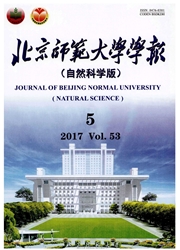

 中文摘要:
中文摘要:
通过对萨拉乌苏河流域滴哨沟湾左岸沉积剖面常量元素Si、Al、Fe、Ca、Mg、K、Na含量及其比值变化的分析,结合~(14)C测年结果及粒度、有机质指标,并综合已有研究,探讨了该地区全新世以来的气候变化.研究表明,9.6ka BP前气候干冷,沉积相为风成沉积;9.6~〉8.4ka BP气候由干冷向暖湿转变,期间存在干冷波动;8.4~〉4.0ka BP进入全新世大暖期,其中,8.4~〉6.5ka BP为全新世大暖期的鼎盛时期,降水增加,积水成湖,湖泊水位高且稳定;6.5ka BP气候发生明显转变;6.5-〉4.0ka BP湖泊水位逐步下降形成富含螺壳的浅水环境,但气候整体仍较为湿润;4.0~〉1.2ka BP气候变干冷,发育沼泽;1.2~〉0.7ka BP气候转暖湿,沉积相由沼泽相转变为湖泊相;0.7~0.5ka BP为河流相沉积,气候较为干冷.剖面记录的气候变化可与东亚季风变化、温度变化、太阳辐射进行对比,反映了该区域气候变化与全球气候变化的一致性.
 英文摘要:
英文摘要:
Abstract The Dishaogouwan stratigraphic section of the Salawusu Ntver valley ts tocatea at the southeastern margin of the Mu Us Desert on the Ordos Plateau of Inner Mongolia, which is the transition zone between the Mu Us Desert and the Loess Plateau and is sensitive to global climate changes. This is an ideal region to study global climate changes. Constant elements such as Si, A1, Fe, Ca, Mg, K, Na and their ratio changes in DSGL section in the Salawusu River region were analzyed, 14C dating combined with elemental geo- chemistry proxies indicated that before 9.6 ka BP, the climate was dry and cold, with strong wind-sand activities. From 9.6-8.4 ka BP, the climate became warm and wet with dry-cold fluctuation. Holocene Climate Optimum period took place from 8.4 -4.0 ka BP, and 8.4 〉 6.5 ka BP was the Mega thermal Maximum, i. e. , the maximum lake period. From 6.5-〉4.0 ka BP, the climate also continued to be wet with the lake started to become smaller. From 4.0-〉 1.2 ka BP interval, the climate turned to be dry and cold, developed swamps. A relatively warmer period occurred in 1.2-〉0.7 ka BP interval. From 0.7-〉0.5 ka BP, the climate turned to be dry and cold again and the river was formed. The record in the profile can be compared with the cold events in the north Atlantic, record from Dongge Cave, average solar radiation, reflecting the consistency of the regional climate change and global climate change.
 同期刊论文项目
同期刊论文项目
 同项目期刊论文
同项目期刊论文
 期刊信息
期刊信息
